Physical Address
304 North Cardinal St.
Dorchester Center, MA 02124
Enteric pathogens are the leading cause of childhood death in the world and the second leading cause of death for people of all ages (second only to cardiovascular disease). In many areas of the world, problems with water quality, sanitation, and food hygiene practice contribute to the transmission of gastrointestinal infectious diseases. Many other aspects of modern living also contribute to the transmission of enteric pathogens, however, including camping and water sports involving untreated water sources; poor swimming pool hygiene; frequent consumption of restaurant-prepared and prepackaged foods; more widespread consumption of raw or poorly cooked meats and seafood; and travel, particularly from an area of good sanitation to one of poor sanitation.
The number of bone marrow and solid organ transplant patients continues to increase as well, as does the population of patients with other immunocompromising conditions. For all of these reasons, and as global urbanization, immigration, and transcontinental travel become more frequent, infectious diseases that were once limited to certain populations or regions of the world can now be found almost anywhere.
The goals of the surgical pathologist in evaluating gastrointestinal specimens for infection are basically twofold. First, the surgical pathologist must attempt to differentiate histologic changes suggesting infection from other inflammatory processes, including chronic idiopathic inflammatory bowel disease (ulcerative colitis or Crohn disease), ischemia, adverse drug reactions, and autoimmune disorders. Following this determination, dedicated attempts must be made to diagnose the specific infectious organism. The surgical pathologist’s ability to detect infectious processes in tissue sections has grown exponentially with the advent of new histochemical and immunohistochemical stains, as well as molecular assays. As these techniques have developed and become more widely available for diagnostic use, our knowledge of the pathologic spectrum that specific infectious organisms can cause has also grown, including our knowledge of those infections that can closely mimic other inflammatory processes.
HELICOBACTER PYLORI
Helicobacter pylori (HP) is a gram-negative bacterium that infects the stomach. Although the incidence of H. pylori infection is decreasing, in part due to eradication, it remains one of the most common bacterial infections worldwide. Infection is associated with many gastrointestinal diseases, including chronic gastritis, atrophic gastritis, peptic ulcers, gastric adenocarcinoma, and lymphomas of the mucosa-associated lymphoid tissue (MALT) type. However, the exact mechanisms by which HP cause disease remain unclear.
Patients with H. pylori -associated gastritis may present with dyspepsia, epigastric pain, nausea, vomiting, and gastrointestinal (GI) bleeding. Many infected patients are asymptomatic, however.
Mucosal changes are nonspecific and include erythema, mucosal granularity, and abnormal vascular pattern. Nodularity of the mucosa may be seen, especially in children, and may correlate with lymphoid hyperplasia. The antrum is most commonly affected, although the fundic and cardiac mucosa also are frequently involved. In general, there is poor correlation between endoscopic findings and the presence or severity of histologic findings.
The inflammatory pattern most commonly associated with HP infection is chronic, active gastritis, featuring a mononuclear cell infiltrate in the lamina propria that is rich in plasma cells, along with neutrophils that may infiltrate the glandular epithelium ( Figure 16-1 A-C). Scattered eosinophils are also common. Lymphoid aggregates are a frequent feature. Significant intraepithelial lymphocytosis may be seen as well. The severity of the inflammation often does not correlate with the number of organisms found. HP is rarely seen overlying areas of intestinal metaplasia.
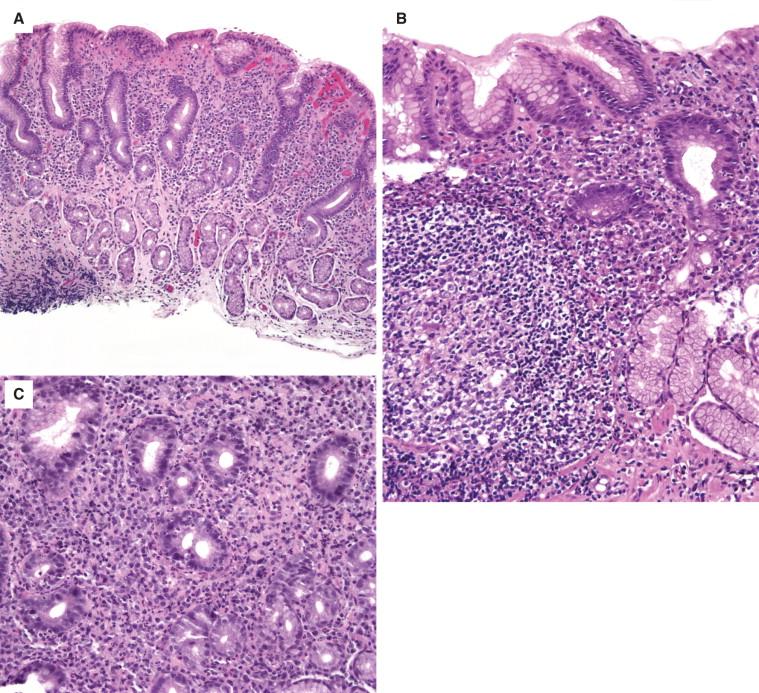
Helicobacter pylori are tiny (2 to 5 μ), slightly basophilic, spirillar, “comma”- or “seagull”-shaped organisms that are present in the mucus layer at the surface of the epithelium ( Figure 16-2 ). They reside both at the luminal surface and in the pits; invasive organisms are seldom seen. The distribution of HP may be very focal and patchy. Under suboptimal conditions, the usually spirillar bacteria may undergo transformation to coccoid forms ( Figure 16-3 ) that closely resemble mucus droplets, nonpathogenic bacteria, or other organisms such as fungal spores or coccidians. Although the precise clinical significance of coccoid forms is uncertain, they are usually associated with spirillar forms, and the diagnosis of HP infection when only coccoid forms are present should be entertained with caution.
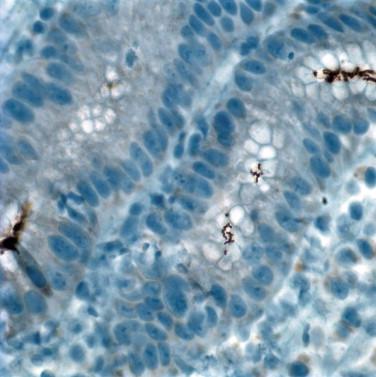
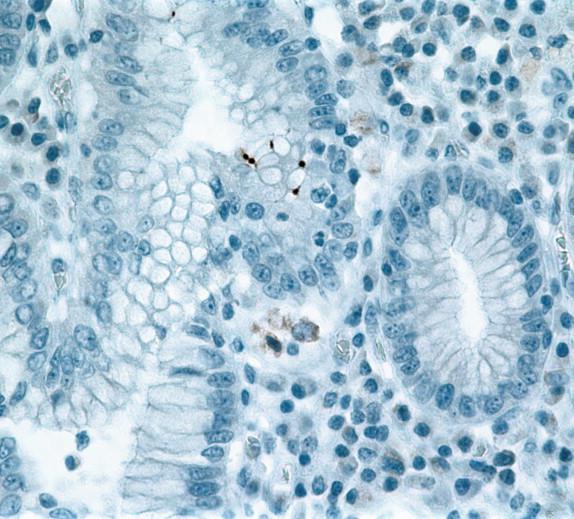
Useful histochemical stains include Giemsa, Diff-Quik, and silver impregnation stains such as the Warthin-Starry or Steiner. The latter may be combined with hematoxylin and eosin (H&E) and alcian blue (pH 2.5) to produce the popular “triple” or “Genta” stain that also allows for evaluation of gastric morphology ( Figure 16-4 ). Silver impregnation stains are expensive and technically more difficult to obtain, but the bacteria are easy to identify using this method as they stain dark black and appear thicker. Gram stain and the fluorescent acridine orange stain also will detect HP, although these are not routinely used. The more recently introduced immunostain ( Figure 16-5 ) has gained popularity due to the ease of identification and the specificity. However, the immunostain may cross-react with other Helicobacter species (discussed later).
Erythema, granularity, abnormal vascular pattern, nodularity.
Plasmacytic infiltrate in the lamina propria.
Neutrophils that infiltrate the glandular epithelium.
Lymphoid aggregates.
Basophilic, spirillar, “seagull”-shaped organisms in mucus layer.
Autoimmune gastritis.
Gastric Crohn disease.
Lymphocytic gastritis associated with celiac disease.
MALT lymphoma.
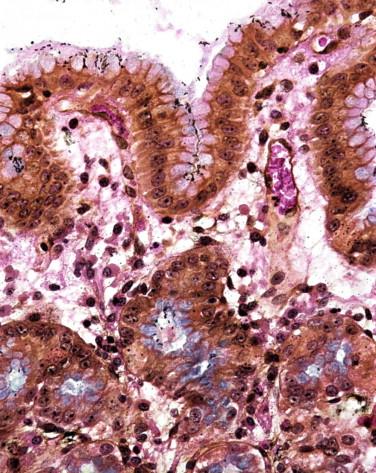
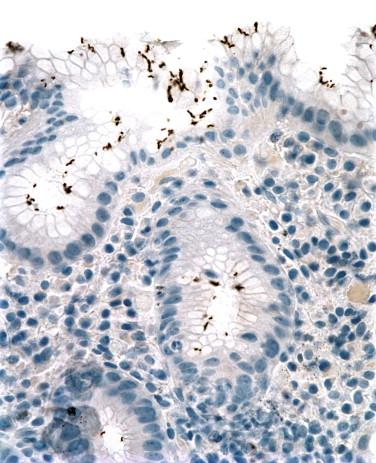
Urease tests (such as the Campylobacter -like organism [CLO] test) are rapid, inexpensive, and have sensitivity and specificity comparable to histology. Breath tests measuring excretion of carbon isotopes are quick, accurate (as a positive result indicates active infection), and noninvasive, but they are expensive, not widely available, and there is a slight radiation exposure with some methods. Serologic studies have excellent sensitivity and specificity, and are inexpensive. A positive result in the absence of treatment implies current infection; however, positive serologic studies may persist for quite some time following eradication of the bacteria. Molecular detection assays also exist, but they are not widely available.
Culture of the organism is extremely difficult and is most commonly used when antibiotic susceptibility testing is needed.
The differential diagnosis primarily includes other causes of nonerosive, nonspecific gastritis, including autoimmune gastritis, Crohn disease, infectious gastroenteritis, adverse drug reaction, and the lymphocytic gastritis associated with celiac disease. If there is a particularly dense inflammatory infiltrate, H. pylori –related gastritis must be distinguished from MALT lymphoma. Architectural destruction, infiltration of lymphocytes into the submucosa, and numerous lymphoepithelial lesions favor a neoplastic process ( Figure 16-6 A and B), but gene rearrangement studies may be required to confirm the diagnosis.
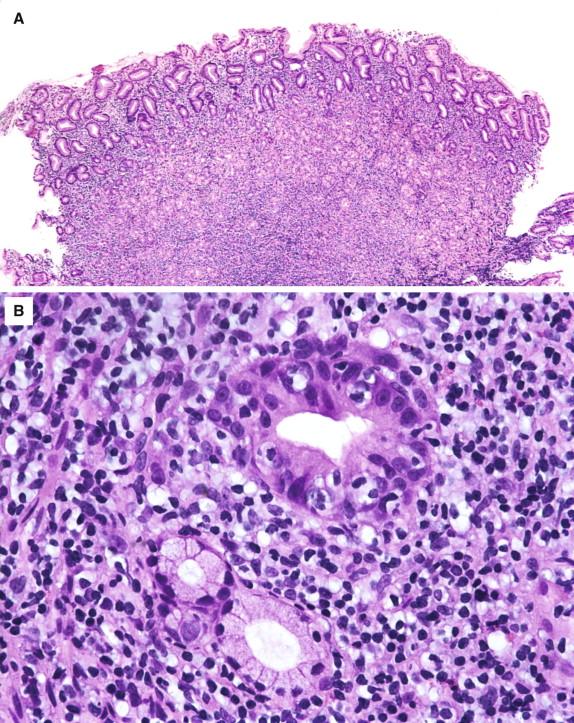
Helicobacter pylori must be distinguished from contaminating oropharyngeal flora, which also may stain on nonspecific histochemical stains, by the morphology of the organism. It must also be distinguished from other less common Helicobacter species (discussed later).
HELICOBACTER HEILMANNII THERAPY
Standard therapy consists of omeprazole and two antibiotics, usually clarithromycin and amoxicillin. Helicobacter heilmannii (HH), a less commonly encountered Helicobacter species formerly known as Gastrospirillum hominis, is associated with animal contact. Coinfection with HP and HH has been well documented.
Symptoms are similar to those for HP, and both children and adults can be affected. Helicobacter heilmannii infection has been associated rarely with ulcer formation, particularly in the context of nonsteroidal anti-inflammatory drug use.
Infection is usually restricted to the antrum. The morphologic features are indistinguishable from HP-associated gastritis, but they are often more focal, less severe, and involve fewer organisms. Intestinal metaplasia, gastric adenocarcinoma, and MALT lymphoma are less commonly associated with HH. H. heilmannii is longer (4 to 10 μ in length) and more tightly spiraled than HP ( Figure 16-7 A, B).
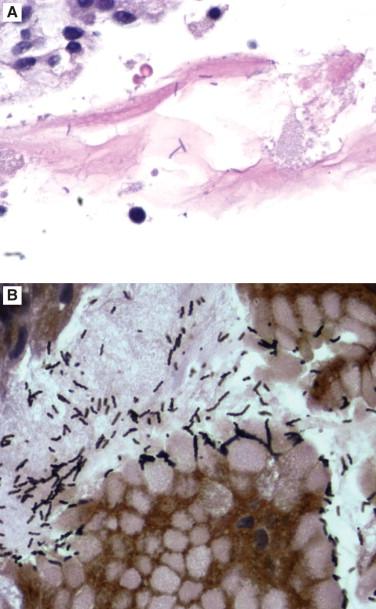
Helicobacter heilmannii is detectable by the same histochemical stains used for HP, and it is also immunopositive for the anti– H. pylori immunohistochemical stains.
The differential diagnosis primarily includes HP-associated gastritis.
Treatment is similar to that for H. pylori .
Diarrhea due to bacterial infection is a significant worldwide health problem. Escherichia coli, Salmonella, Shigella, and Campylobacter are the most commonly identified pathogens, and many bacterial infections of the gut are related to ingestion of contaminated water or food, or travel to foreign countries. Although bacteria are often recovered by culture, surgical pathologists may play a valuable role in diagnosis.
Most enteric infections are self-limited. Patients who undergo endoscopic evaluation and biopsy generally have unusual clinical features such as chronic or debilitating diarrhea, evidence of systemic disease, or a history of immunocompromise. One of the most valuable (and least expensive) diagnostic aids for the surgical pathologist is a discussion with the gastroenterologist regarding specific symptoms, colonoscopic findings, travel history, food intake history (such as sushi or poorly cooked beef), sexual practices, and immune status.
Despite the large number of infectious agents that may affect the colon, the histologic features that they produce may be generally categorized as follows, and a general classification of colonic bacterial infections by histologic pattern is given in Table 16-1 :
Organisms producing very mild or no histologic changes (such as enteroadherent E. coli or toxigenic V. cholerae O1).
Organisms producing the histologic features of acute infectious type/self-limited colitis (AITC) or focal active colitis (FAC); many bacterial infections are in this category, including Campylobacter, Aeromonas, and some Salmonella species.
Organisms producing suggestive or diagnostic histologic features, such as pseudomembranes or granulomas.
| Minimal or No Inflammatory Change | Acute Self-Limited Colitis Pattern | Pseudo-membranous Pattern | Predominantly Granulomatous | Diffuse Histiocytic | Predominantly Lymphohistiocytic | Architectural Distortion | Ischemic Pattern |
|---|---|---|---|---|---|---|---|
| Toxigenic Vibrio cholerae O1 Enteropathogenic E. coli Enteroadherent E. coli Spirochetosis Neisseria species |
Shigella Campylobacter Aeromonas Occasionally Salmonella (especially nontyphoid) Other Vibrio species Occasionally C. difficile Syphilis (+/− increased plasma cells) |
Enterohemorrhagic E. coli C. difficile Occasionally Shigella |
Yersinia M. tuberculosis Actinomycosis MAI (immunocompetent patients) |
Rhodococcus equi Whipple’s disease MAI (immunocompromised patients |
LGV Salmonella typhimurium |
Marked: Salmonella typhimurium Shigella Focal or mild: Aeromonas Campylobacter |
Enterohemorrhagic E. coli C. difficile |
Surgical pathologists should also be aware of the infections that are most likely to mimic other inflammatory bowel diseases, particularly Crohn disease, ulcerative colitis, and ischemic colitis ( Table 16-2 ).
| Mimics of Crohn Disease | Mimics of Ulcerative Colitis | Mimics of Ischemic Colitis |
|---|---|---|
| Salmonella typhimurium | Shigella species | Enterohemorrhagic E. coli |
| Shigella species | Nontyphoid Salmonella species | C. difficile (pseudomembranous colitis) |
| Yersinia | Aeromonas species | C. perfringens |
| M. tuberculosis | Campylobacter (rarely) | |
| Aeromonas species | Lymphogranuloma venereum | |
| Campylobacter (rarely) | ||
| Lymphogranuloma venereum |
The acute infectious-type colitis (AITC) pattern, also known as the acute self-limited colitis (ASLC) pattern, is one of the patterns most commonly seen in enteric infections. Because infections are not always self-limited and may even be fatal, many pathologists and clinicians prefer the essentially synonymous term acute infectious-type colitis .
The characteristic findings in AITC can be summarized as cryptitis in a background of preserved crypt architecture ( Figure 16-8 ). Other characteristic findings include neutrophils in the lamina propria, crypt abscesses, crypt rupture, edema, and surface epithelial damage with superficial mucosal erosion. The acute inflammatory component is often most prominent in the mid- to upper levels of the crypts. The inflammatory changes may be focal or diffuse. The lamina propria may contain increased mononuclear cells as well as neutrophils, but basal plasma cells should not be present.
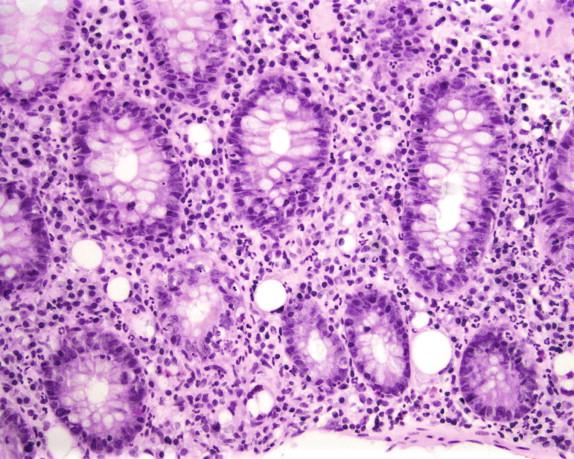
Histologic changes of chronicity are usually present even in the initial biopsy specimen in patients with chronic idiopathic inflammatory bowel disease (CIIBD), and the lack of features of chronicity (crypt distortion, Paneth cell metaplasia, and basal lymphoplasmacytosis) helps to distinguish AITC from CIIBD. Further complicating this issue is that many enteric pathogens may cause exacerbations or relapses of CIIBD, producing a histologically confusing picture; this reinforces the necessity of a diligent search for pathogens (including stool cultures) even in patients with the established diagnosis of CIIBD.
Focal active colitis (FAC) is the term that should be used to describe focal neutrophilic crypt injury ( Figure 16-9 ). The spectrum of morphologic changes encompassed by the term FAC ranges from a single crypt abscess or focus of cryptitis to multiple foci of neutrophilic cryptitis or crypt abscesses within one or more large bowel biopsies. Infection, particularly resolving infection, is the most common underlying cause of FAC (discussed later), although adverse drug reaction, bowel prep injury, and Crohn disease (particularly in children) also can produce this spectrum of morphologic changes.
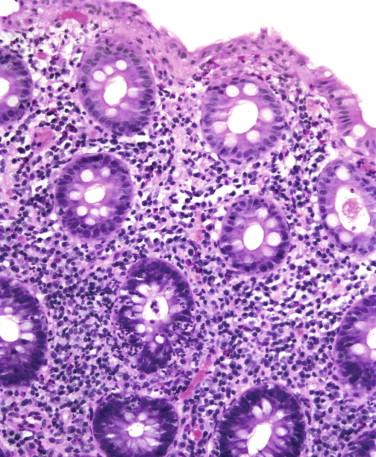
Because most patients do not present for endoscopy until several weeks after the onset of symptoms, pathologists are less and less frequently exposed to the classic histologic features of AITC as described previously. This is important, because the resolving phase of infectious colitis is more challenging to diagnose. At this stage, one may find only occasional foci of neutrophilic cryptitis (focal active colitis) and a patchy increase in lamina propria inflammation, which may, in fact, contain abundant plasma cells and increased intraepithelial lymphocytes ( Figure 16-10 ). Because these features are also seen in Crohn disease and in lymphocytic colitis, it is important to be aware of the patient’s symptoms (particularly acute versus chronic onset) and, ideally, the culture results, because the exact diagnosis may be difficult to resolve on histologic grounds alone.
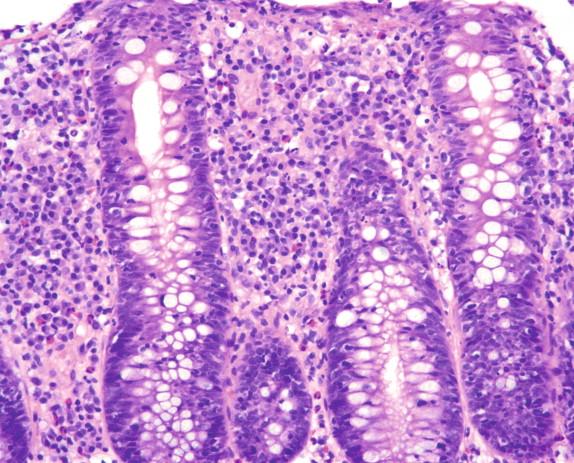
Aeromonas species, initially thought to be nonpathogenic gram-negative bacteria, are increasingly recognized as causes of gastroenteritis in both children and adults. Aeromonas hydrophila and A. sobria most often cause gastrointestinal disease in humans. Infection usually results from exposure to untreated water but also may result from consuming contaminated foods such as produce, meat, and dairy products.
Children are most commonly affected, and infections most frequently present in the late spring, summer, and early fall. A mild, self-limited diarrheal illness is most common, sometimes accompanied by nausea, vomiting, and cramping abdominal pain. A more severe, dysentery-like illness occurs in 15% to 25% of patients, featuring bloody or mucoid diarrhea and fecal leukocytes. This variant is most likely to mimic chronic idiopathic inflammatory bowel disease endoscopically. A few patients experience a subacute, chronic diarrhea lasting months to years, and the chronic nature of the symptoms may mimic chronic idiopathic inflammatory bowel disease clinically.
Gram-negative bacterial infection usually resulting from exposure to contaminated water; increasingly recognized as cause of infectious enterocolitis.
Colon, often segmental distribution.
Diarrhea (can be mucoid or bloody); nausea, vomiting, cramping pain.
Most cases resolve spontaneously; susceptible to many antibiotics if needed.
Endoscopically, signs of colitis may be seen, including edema, friability, erosions, exudates, and loss of vascular pattern; the features are often segmental and may mimic ischemic colitis or Crohn disease. A pancolitis mimicking ulcerative colitis has also been described.
The histologic features are usually those of acute self- limited colitis (discussed previously) ( Figure 16-11 ). Ulceration and focal architectural distortion may be seen in some cases ( Figure 16-12 ).
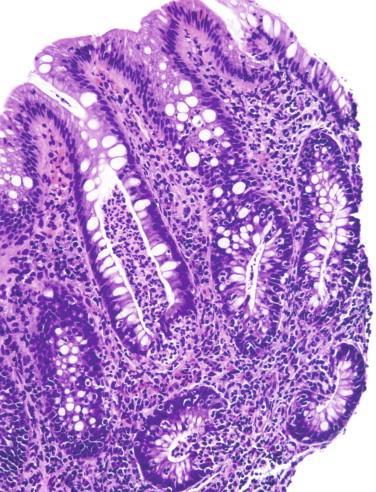
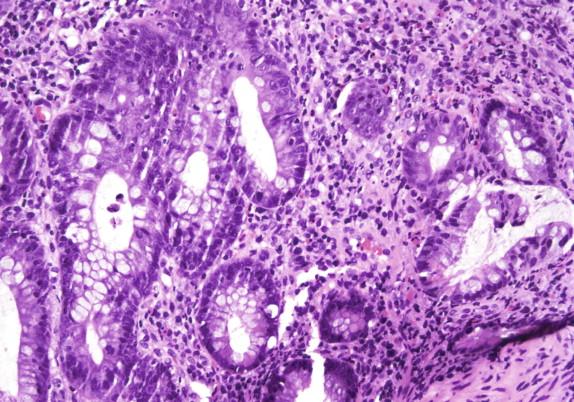
Stool cultures are critical to diagnosis.
Edema, friability, erosions, exudates, and loss of vascular pattern.
Often segmental.
Pancolitis mimicking ulcerative colitis rarely described.
Usually those of acute self-limited colitis.
Ulceration and focal architectural distortion may be seen.
Other enteric infections.
Crohn disease (gross and microscopic).
Ischemic colitis (particularly grossly).
Ulcerative colitis (grossly, if pancolitis present).
The differential diagnosis includes other infectious processes, ischemic colitis, and chronic idiopathic inflammatory bowel disease. Culture should help exclude other infections, and typical features of ischemia (crypt withering, mucosal necrosis) are not present with Aeromonas . When architectural distortion is present in a patient with chronic symptoms, it may be difficult to resolve the issue of Aeromonas infection versus CIIBD. Some authorities recommend culturing for Aeromonas in all patients with refractory CIIBD, as well as patients (particularly children) with a presumed initial presentation of CIIBD. Although there are no histologic features specific for Aeromonas infection (as with many infections of the gastrointestinal tract), it is important for the surgical pathologist to realize that this is one of the bacteria that can most closely mimic CIIBD.
Most cases resolve spontaneously. Aeromonas is susceptible to many antibiotics, which can be used in severe or chronic infections.
Campylobacter (derived from the Greek for “curved rod”) species are a major cause of diarrhea worldwide and the most common stool isolate in the United States. Infection is most commonly associated with consuming undercooked poultry, raw milk, or untreated water. Campylobacter jejuni is most commonly associated with foodborne gastroenteritis; C. fetus and the other less common species are more often seen in immunosuppressed patients and homosexual men.
Campylobacter infects patients of all ages, but infants, children, and young adults are most often affected. The incidence in HIV-positive patients is higher than in the general population, and severe, chronic, recurrent, or disseminated infections are more common in this group. Campylobacter infection is associated with the subsequent development of several autoimmune disorders, including Guillain-Barré syndrome, Henoch-Schönlein purpura, and reactive arthropathy. Campylobacter infection may also cause exacerbations of underlying CIIBD.
Patients typically have fever, malaise, abdominal pain (often severe), and watery diarrhea, often bloody and with fecal leukocytes. Abdominal pain may be the dominant symptom in many patients. Nausea, vomiting, tenesmus, headache, and myalgias are variably present. Symptoms generally resolve within 1 to 2 weeks, but relapse is common.
Foodborne enteric infection, most common stool isolate in the United States.
Colon.
Fever, malaise, abdominal pain, watery diarrhea, often bloody and with fecal leukocytes.
Infection generally self-limited, although relapse is frequent.
Infection more severe in immunocompromised patients.
Associated with Guillain-Barré syndrome.
Supportive care in most cases.
Erythromycin in severe cases, immunocompromised patients.
Endoscopic findings include friable colonic mucosa with associated erythema and hemorrhage. Ulceration and inflammatory exudates may be present. Colonoscopy may be unremarkable, however.
Histologic examination shows features of acute self-limited colitis (discussed previously) ( Figure 16-13 ). Mild crypt distortion may occasionally be seen, although architecture overall is preserved.
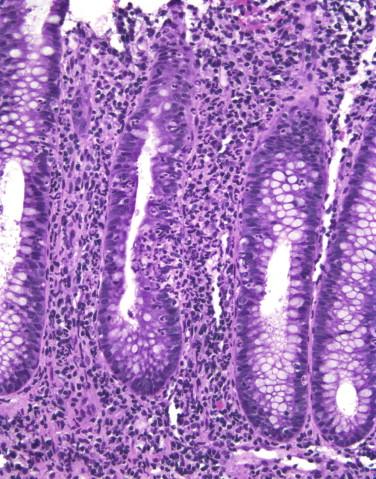
The mainstay of laboratory diagnosis is culture of Campylobacter from stool or blood, or detection of Campylobacter antigens by immunoassay.
The differential diagnosis primarily includes other forms of infectious enterocolitis that produce the AITC or FAC pattern. Occasionally, when crypt distortion is seen, Campylobacter colitis can mimic CIIBD.
Friable colonic mucosa.
Erythema and hemorrhage.
Acute self-limited colitis pattern.
Occasionally has crypt distortion.
Other infections that cause the acute self-limited colitis pattern.
Rarely, Crohn disease if architectural distortion present.
In most uncomplicated cases, fluid and electrolyte replacement is the principal therapy. Antibiotics (usually erythromycin) are not generally indicated unless there is high fever, severe or bloody diarrhea, symptoms of more than 1 week, or the patient is immunocompromised or septic.
The majority of medically important Salmonella are in the species S. enterica. These are differentiated by their serotyping, but the nomenclature has changed. Rather than S. enteritidis, for example, the bacterium is designated S. enterica serotype Enteritidis, or simply, S. Enteritidis. These gram-negative bacilli are transmitted through food and water and are prevalent where sanitation is poor. They are an important cause of both food poisoning and traveler’s diarrhea. The discussion of Salmonella species can be generally divided into typhoid and nontyphoid species. Enteric (typhoid) fever is usually caused by S. Typhi but may also be caused by S. Paratyphi; the most common nontyphoid species include S. Enteritidis, S. Typhimurium , S. Muenchen , S. Anatum, S. Paratyphi, and S. Give. Although historically enteric fever was considered a much more severe disease and nontyphoid salmonellosis a milder one, more recent literature suggests a greater degree of overlap (both clinically and pathologically) than previously thought. Patients with low gastric acidity are at increased risk of salmonellosis, and patients with AIDS have a greater risk of Salmonella infection as well as a greater likelihood of severe infection and septicemia.
Become a Clinical Tree membership for Full access and enjoy Unlimited articles
If you are a member. Log in here